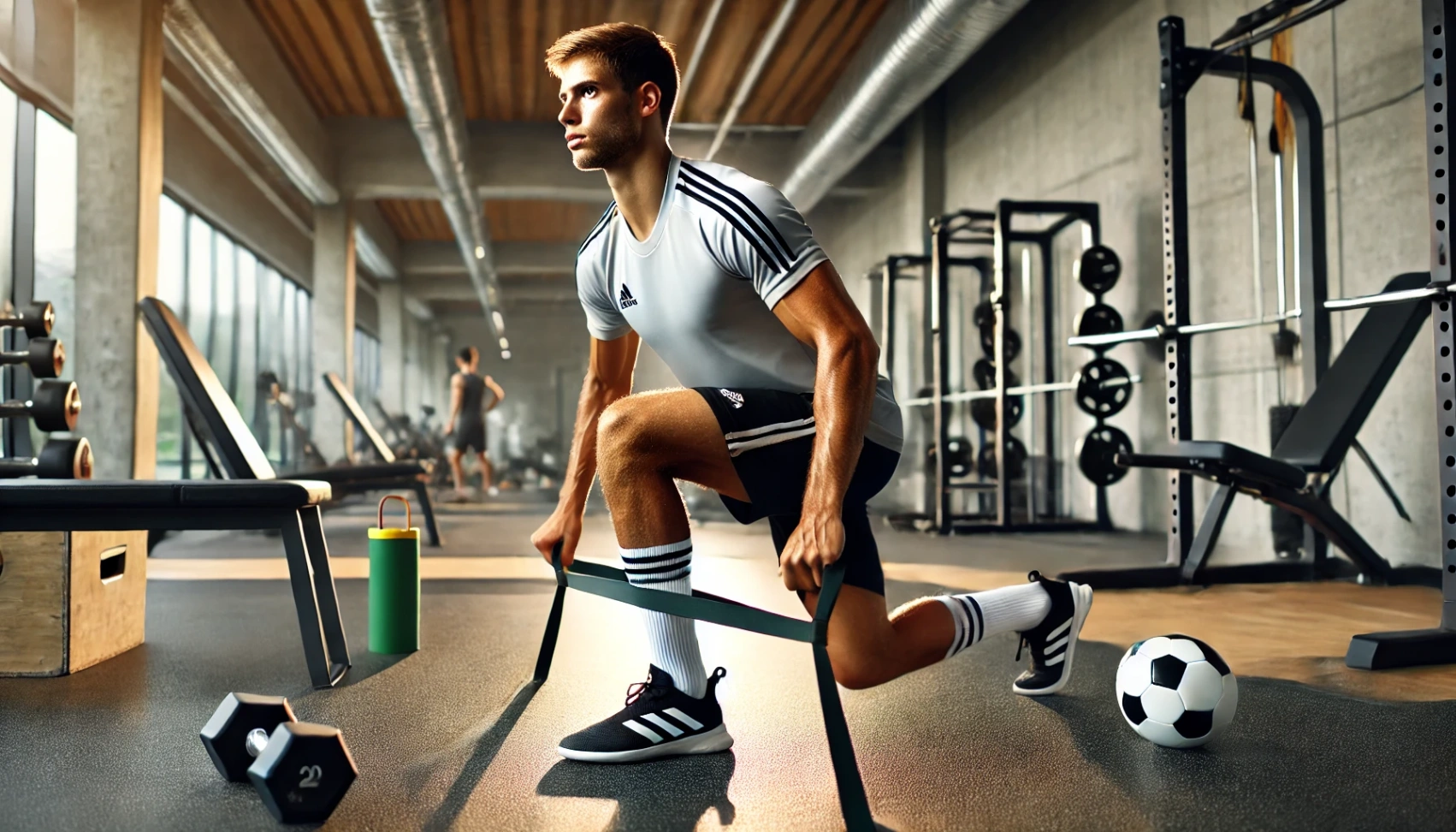
Strength training is essential for soccer players to enhance their power, speed, and endurance.
By targeting key muscle groups and incorporating specific exercises, players can improve their performance, reduce injury risks, and gain a competitive edge.
This guide highlights the most effective strength exercises to boost explosive power and athleticism.
Why Strength Training is Important
Strength training is crucial for soccer players to improve performance and minimize injury risks. Here’s why it matters:
- Boosts Explosive Power: Improves sprinting, jumping, and quick direction changes.
- Increases Endurance: Enhances stamina for long-lasting performance on the field.
- Enhances Agility: Allows faster and more precise movements during the game.
- Reduces Injury Risk: Strengthens muscles, ligaments, and joints, preventing common injuries like ACL tears.
- Improves Overall Balance: Helps maintain stability during physical confrontations.
- Supports Recovery: Aids in faster recovery between matches or training sessions.

Key Muscle Groups for Soccer
Soccer strength training targets specific muscle groups essential for improving power, speed, and agility. Here are the key areas to focus on:
- Quadriceps: Crucial for sprinting and powerful kicks.
- Hamstrings: Supports explosive speed and prevents injury.
- Glutes: Drives power for running and jumping.
- Calves: Helps with sprinting and quick directional changes.
- Core Muscles: Stabilizes the body for balance and rotational movements.
- Upper Body (Shoulders and Arms): Important for physical duels and maintaining control during contact.
Essential Strength Exercises for Soccer Players
Strength exercises are vital for soccer players to enhance their power, agility, and endurance.
Below are the essential exercises that focus on building strength and improving on-field performance.
Squats
- Builds lower-body strength for sprinting and jumping.
- Variations: Front squats, back squats, goblet squats.
Deadlifts
- Full-body strength is vital for explosive movements.
- Prevents hamstring injuries with proper technique.
Lunges
- Improves single-leg strength and balance for kicking and sprinting.
- Variations: Walking lunges, reverse lunges, Bulgarian split squats.
Box Jumps
- Develops explosive power for jumping and quick sprints.
- Focus on proper landing to prevent injuries.
Planks
- Strengthens core for stability and balance during games.
- Variations: Side planks, forearm planks, dynamic planks.
Push-ups
- Upper-body strength is essential for physical confrontations.
- Variations: Standard, plyometric, and incline push-ups.
Additional Power-Building Exercises
These power-building exercises are essential for soccer players to improve explosive movements and overall performance.
- Hip Thrusts: Builds glute strength for sprint acceleration and jumping.
- Step-ups: Improves single-leg power and balance, essential for running and agility.
- Medicine Ball Throws: Develops rotational power for long passes, kicks, and shots.
- Plyometric Exercises: Boosts explosive power with depth jumps, lateral hops, and bounding.

Plyometrics for Explosive Power
Plyometric exercises are essential for building explosive power in soccer players and for improving speed, agility, and jumping ability.
Below are vital plyometric exercises:
Depth Jumps
- Boosts vertical jump power for heading and aerial duels.
- Focus on landing mechanics to reduce injury risk.
Bounding
- Enhances sprinting ability with long, powerful strides.
- Improves explosive movement over longer distances.
Lateral Hops
- Increases agility and quick direction changes.
- Useful for dodging opponents and swift lateral movement on the field.
Box Jumps
- Develops leg power for sprint starts and explosive take-offs.
- Focus on controlled landings for balance and injury prevention.
Single-Leg Hops
- Builds unilateral leg strength and balance, essential for kicking and running.
- Helps improve coordination and stability.
Tuck Jumps
- Improves explosive leg power by jumping as high as possible and tucking knees.
- Enhances quick jumping ability for both offensive and defensive actions.
Building a Strength Training Routine for Soccer
Creating an effective strength training routine for soccer requires balancing exercises with practice sessions and matches.
Below are the key factors to consider when building a soccer-specific routine.
Frequency
- Aim for 2-3 strength sessions per week.
- Avoid overtraining by allowing rest days between sessions for recovery.
Progressive Overload
- Gradually increase weights and intensity over time to build strength.
- Focus on adding small increments to avoid injury while continuing to improve.
Incorporate Full-Body Workouts
- Include exercises targeting each session’s lower, core, and upper body.
- Prioritize functional movements that simulate soccer actions.
Balance Strength with Endurance
- Combine strength training with cardio and agility drills to maintain fitness levels.
- Incorporate high-intensity interval training (HIIT) to blend strength and stamina.
Rest and Recovery
- Schedule recovery days to allow muscles to repair and grow.
- Use active recovery techniques like stretching, foam rolling, or light cardio.
Mobility and Flexibility
- Include dynamic stretching and mobility exercises to maintain a full range of motion.
- Improves flexibility, preventing injuries and enhancing athletic performance.
Adapt to Match Schedule
- Adjust strength training intensity based on upcoming matches to avoid fatigue.
- Lighten the load close to game days for peak performance during matches.

Periodization for Soccer Players
Periodization is a structured approach to training that helps soccer players optimize performance throughout the season by varying intensity and focus.
Here’s how to implement periodization effectively for soccer players.
Pre-Season (Preparation Phase)
- Focus on building a solid foundation of strength, endurance, and flexibility.
- Increase training volume with moderate intensity to prepare the body for the season ahead.
In-Season (Competition Phase)
- Prioritize maintenance of strength and power without overloading the body.
- Reduce training volume while maintaining intensity to ensure freshness for matches.
Tapering Before Matches
- Decrease training intensity a few days before a match to allow full recovery.
- Focus on light exercises, mobility, and mental preparation.
Post-Season (Transition Phase)
- Allow time for rest and recovery after the season ends to prevent burnout.
- Incorporate light exercises and active recovery to maintain general fitness.
Off-Season (Rebuilding Phase)
- Gradually reintroduce strength training to rebuild any lost muscle and strength.
- Focus on addressing weaknesses, improving overall fitness, and preparing for the next season.
Adjusting to Player’s Needs
- Periodization should be customized based on individual player roles, position, and injury history.
- Flexibility in the plan is vital to addressing specific weaknesses and areas of improvement.
Recovery Strategies After Strength Training
Recovery is crucial after strength training to prevent injury and promote muscle growth.
Here are effective recovery strategies for soccer players post-workout.
- Hydration: Replenish lost fluids to support muscle recovery and prevent cramping.
- Proper Nutrition: Consume protein and carbohydrates post-workout to aid muscle repair and replenish energy stores.
- Stretching: Incorporate static stretching after training to improve flexibility and reduce muscle stiffness.
- Foam Rolling: Use foam rollers to release muscle tension and prevent soreness.
- Rest Days: Schedule rest days to allow muscles to repair and recover.
- Sleep: Aim for 7-9 hours to promote full-body recovery and enhance performance.
- Cold Therapy: Apply ice packs or cold baths to reduce inflammation and muscle fatigue.
To Wrap Up
Strength training is essential for soccer players to boost power and endurance and prevent injuries, ultimately enhancing on-field performance.
Players can consistently improve their strength and agility by incorporating essential exercises and following a structured routine.
Start implementing these exercises into your training today to take your game to the next level.






